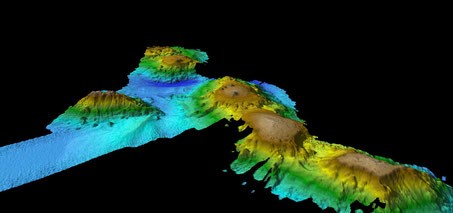
Source CSIRO
The CSIRO research vessel Investigator has revealed a chain of volcanic seamounts in deep water about 400 km east of Tasmania. The seamounts are 3000 m high but still 2000 m below the surface. ” The seamounts vary in size and shape, “This is a very diverse landscape and will undoubtedly be a biological hotspot that supports a dazzling array of marine life”. Ship data collected during the voyage revealed spikes in ocean productivity over the chain of seamounts, with increased phytoplankton activity and marine animal observations in the area.
Dr Eric Woehler from BirdLife Tasmania, who was on Investigator with a team conducting seabird and marine mammal surveys, was astounded by the amount of life they saw above the seamounts.

“While we were over the chain of seamounts, the ship was visited by large numbers of humpback and long-finned pilot whales,” Dr Woehler said. “We estimated that at least 28 individual humpback whales visited us on one day, followed by a pod of 60-80 long-finned pilot whales the next. We also saw large numbers of seabirds in the area including four species of albatross and four species of petrel.”
“Clearly, these seamounts are a biological hotspot that supports life, both directly on them, as well as in the ocean above,” he said.
“These seamounts may act as an important signpost on an underwater migratory highway for the humpback whales we saw moving from their winter breeding to summer feeding grounds,” Dr Woehler said
